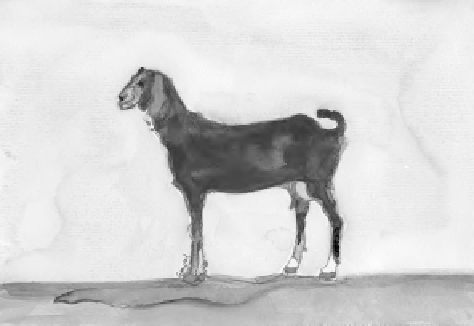Agriculture Reference
In-Depth Information
Figure 2.8
Barbari (Dairy Goat). For color detail,
see Appendix A.
Figure 2.9
Black Beetal (Dairy Goat). For color
detail, see Appendix A.
Barbari
This small breed of goats originated in Rajasthan of India
and Sandi of Pakistan. These goats have small erect horns
and short hair. A white coat with tan spots is common.
Adult females are 27 - 36 kg (60 - 79 lb) in weight. This
breed has been selected for milk production and is very
prolifi c with twins and triplets being common (Devendra,
2007 ). See Figure 2.8 .
Beetal
Although this breed looks similar to Jamunapari, it is
smaller in size. This breed is widely distributed in both
Punjab provinces of India and Pakistan along with sur-
rounding areas in Rawalpindi and Lahore. The coat color
usually is red but black also is common. The ears are pendu-
lous, and the horns are twisted. The adult male goats weigh
about 65 kg (143 lb) while adult females weigh about 45 kg
(100 lb) (OSU, 2004). The average lactation yield is about
195 kg (430 lb) in 224 days (Devendra and Burns, 1983).
Meat production is remarkable, so this breed is classifi ed as
a dual-purpose breed. The dressing percentage is reported to
be 46.9% (Bhatnagar et al., 1971 ). See Figure 2.9 .
Figure 2.10
Damascus (Dairy Goat). For color
detail, see Appendix A.
Damascus
This prominent goat breed is spread across the Middle
East, especially Syria and Lebanon. They are known as
Baladi or Shami, and Aleppo in Turkey (OSU, 2004). This
is a dairy breed that contains some Nubian blood. Color
usually is red or brown but also may be pied or grey. The
hair is long, and males have tassels. Both horned and
polled types are produced. See Figure 2.10 .
Canary Island
This Spanish dairy goat also is used as a meat animal. The
breed is very hardy with good mothering ability. Their coat
color is variable, and they have saber to twisted horns with a
straight face. The ears are drooping, and animals are medium
to large in size
.
They are good milk producers averaging
300 - 400 kg (661 - 882 lb) milk with 5% fat when milked
once per day (Mason, 1981). The breed is considered very
hardy and resistant to disease with a high twinning ability.
Golden Guernsey
This breed was developed from local breeds by cross-
breeding with Anglo-Nubian and Swiss dairy breeds










